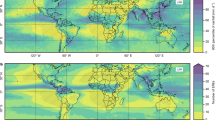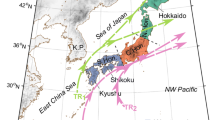Abstract
We investigate the temporal evolution of moisture divergence and its spatial clustering properties over South America. Our analysis focuses on dependencies on the phase of the El Niño Southern Oscillation (ENSO). Moisture divergence is computed from daily reanalysis data of vertically integrated moisture flux provided by Modern-Era Retrospective Analysis for Research and Applications for the time period from 1979 to 2010. We use a sliding-window approach to construct a sequence of complex networks, each obtained from synchronization of events of strong positive (negative) moisture divergence, which we interpret as strong evapotranspiration (precipitation) events. We make the following three key observations: (1) Moisture divergence values over the Amazon rainforest are typically higher during positive ENSO periods (El Niño events). (2) The spatial coherence of strong positive (upwelling) events assumes a characteristic pattern of reduced coherence in this area during El Niño conditions. This influence of ENSO on moisture divergence and its spatial coherence is dominated by the El Niño events of 1982, 1987, and 1997. (3) The clustering characteristics of the obtained climate networks qualitatively agree with the spatial distribution of connected regions with simultaneous events (i.e., events that occur at the same time), but provide a more detailed view on the spatial organization of strong atmospheric upwelling events. Interestingly, no comparable results are found for negative extremes of moisture divergence (strong precipitation events).














Similar content being viewed by others
Notes
References
Ashok K, Behera SK, Rao SA, Weng H, Yamagata T (2007) Recent global-warming hiatus tied to equatorial Pacific surface cooling. J Geophys Res Ocean 112(C11007):1–27
Barros V, Clarke R, Dias P (2006) Climate Change in the La Plata Basin, Consejo Nacional de Investigaciones Científicas y Técnicas, 104 p
Berezin Y, Gozolchiani A, Guez O, Havlin S (2012) Stability of climate networks with time. Sci Rep 2:1–8
Boers N, Bookhagen B, Marwan N, Kurths J, Marengo J (2013) Complex networks identify spatial patterns of extreme rainfall events of the South American monsoon system. Geophys Res Lett 40(16):4386–4392. doi:10.1002/grl.50681
Bookhagen B, Strecker MR (2008) Orographic barriers, high-resolution TRMM rainfall, and relief variations along the eastern Andes. Geophys Res Lett 35(6):L06403
Bookhagen B, Strecker M (2010) Modern Andean rainfall variation during ENSO cycles and its impact on the Amazon drainage basin. In: Hoorn C, Wesselingh FP (eds) Amazonia: Landscape and Species Evolution: A look into the past. Wiley, Oxford, pp 223–243
Cazes-Boezio G, Robertson AW, Mechoso CR (2003) Seasonal dependence of ENSO teleconnections over South America and relationships with precipitation in Uruguay. J Clim 16:1159–1176. doi:10.1175/1520-0442(2003)16<1159:SDOETO>2.0.CO;2
Davidson Ea, de Araújo AC, Artaxo P, Balch JK, Brown IF, Bustamante MMC, Coe MT, DeFries RS, Keller M, Longo M, Munger JW, Schroeder W, Soares-Filho BS, Souza CM, Wofsy SC (2012) The Amazon basin in transition. Nature 481(7381):321–328. doi:10.1038/nature10717
Donges JF, Zou Y, Marwan N, Kurths J (2009a) Complex networks in climate dynamics. Eur Phys J Spec Top 174(1):157
Donges JF, Zou Y, Marwan N, Kurths J (2009b) The backbone of the climate network. Europhys Lett (EPL) 87(4):48007
Durkee JD, Mote TL, Shepherd JM (2009) The contribution of mesoscale convective complexes to rainfall across subtropical South America. J Clim 22(17):4590–4605
Durkee JD, Mote TL (2010) A climatology of warm-season mesoscale convective complexes in subtropical South America. Int J Climatol 30(3):418–431
Eltahir EaB, Bras RL (1993) Precipitation recycling in the Amazon basin. Q J R Meteorol Soc 120(518):861–880. doi:10.1002/qj.49712051806
Garreaud R, Wallace J (1997) The diurnal march of convective cloudiness over the Americas. Mon Weather Rev 125(12):3157–3171
Hastenrath S, Heller L (1977) Dynamics of climatic hazards in Northeast Brazil. Q J R Meteorol Soc 103:77–92. doi:10.1002/qj.49710343505
Hendon HH, Lim E, Wang G, Alves O, Hudson D (2009) Prospects for predicting two flavors of El Niño. Geophys Res Lett 36(19):L19713
Hill KJ, Taschetto AS, England MH (2009) South American rainfall impacts associated with inter-El Niño variations. Geophys Res Lett 36. doi:10.1029/2009GL040164
Hill KJ, Taschetto AS, England MH (2011) Sensitivity of South American summer rainfall to tropical Pacific Ocean SST anomalies. Geophys Res Lett 38. doi:10.1029/2010GL045571
Houston J (2006a) Variability of precipitation in the Atacama Desert: its causes and hydrological impact. Int J Climatol 26(15):2181–2198. doi:10.1002/joc
Houston J (2006b) Evaporation in the Atacama Desert: an empirical study of spatio-temporal variations and their causes. J Hydrol 330(3–4):402–412. doi:10.1016/j.jhydrol.2006.03.036
Hu ZZ, Kumar A, Jha B, Wang W, Huang B, Huang B (2012) An analysis of warm pool and cold tongue El Niños: air–sea coupling processes, global influences, and recent trends. Clim Dyn 38(9–10):2017–2035
Kim W, Yeh SW, Kim JH, Kug JS, Kwon M (2011) The unique 2009/2010 El Niño event: a fast phase transition of warm pool El Niño to La Niña. Geophys Res Lett 38(15):L15809
Kosaka Y, Xie SP (2013) Recent global-warming hiatus tied to equatorial Pacific surface cooling. Nature 501(7467):403–407. doi:10.1038/nature12534
Lean J, Warrilow D (1989) Simulation of the regional climatic impact of Amazon deforestation. Nature 342:411–413
Lenton TM, Held H, Kriegler E, Hall JW, Lucht W, Rahmstorf S, Schellnhuber HJ (2008) Tipping elements in the Earth’s climate system. Proc Nat Acad Sci 105(6):1786–1793. doi:10.1073/pnas.0705414105
Li W, Zhang P, Ye J, Li L (2011) Impact of two different types of El Nino events on the Amazon climate and ecosystem productivity. J Plant Ecol 4:91–99. doi:10.1093/jpe/rtq039
Ludescher J, Gozolchiani A, Bogachev MI, Bunde A, Havlin S, Schellnhuber HJ (2013) Improved El Niño forecasting by cooperativity detection. Proc Natl Acad Sci 110(29):11742–11745
Malik N, Marwan N, Kurths J (2010) Spatial structures and directionalities in monsoonal precipitation over South Asia. Nonlinear Process Geophys 17(5):371–381
Malik N, Bookhagen B, Marwan N, Kurths J (2012) Analysis of spatial and temporal extreme monsoonal rainfall over South Asia using complex networks. Clim Dyn 39(3):971–987. doi:10.1007/s00382-011-1156-4
Marengo JA, Nobre C, Tomasella J, Oyama M, Sampaio de Oliveira G, de Oliveira R, Camargo H, Alves L, Brown F (2008) The drought of Amazonia in 2005. J Clim 21(3):495–516. doi:10.1175/2007JCLI1600.1
Meehl GA, Arblaster JM, Fasullo JT, Hu A, Trenberth KE (2011) Model-based evidence of deep-ocean heat uptake during surface-temperature hiatus periods. Nat Clim Change 1(7):360–364. doi:10.1038/nclimate1229.http://www.nature.com/nclimate/journal/v1/n7/abs/nclimate1229.html#supplementary-information
Paluš M, Hartman D (2011) Discerning connectivity from dynamics in climate networks. Nonlinear Process Geophys 18:751–763. doi:10.5194/npg-18-751-2011
Quiroga RQ, Kreuz T, Grassberger P (2002) Event synchronization: a simple and fast method to measure synchronicity and time delay patterns. Phys Rev E 66(4):41904
Radebach A, Donner R, Runge J, Donges J, Kurths J (2013) Disentangling different types of El Niño episodes by evolving climate network analysis. Phys Rev E 88:052807. doi:10.1103/PhysRevE.88.052807
Rasmusson E, Carpenter T (1982) Variations in tropical sea surface temperature and surface wind fields associated with the Southern Oscillation/El Niño. Mon Weather Rev 110:354–384. doi:10.1175/1520-0493(1982)110<0354:VITSST>2.0.CO;2
Rheinwalt A, Marwan N, Kurths J, Werner P, Gerstengarbe FW (2012) Boundary effects in network measures of spatially embedded networks. Europhys Lett (EPL) 100(2):28002
Rienecker MM, Suarez MJ, Gelaro R, Todling R, Bacmeister J, Liu E, Bosilovich MG, Schubert SD, Takacs L, Kim GK, Bloom S, Chen J, Collins D, Conaty A, Da Silva A, Gu W, Joiner J, Koster RD, Lucchesi R, Molod A, Owens T, Pawson S, Pegion P, Redder CR, Reichle R, Robertson FR, Ruddick AG, Sienkiewicz M, Woollen J (2011) MERRA: NASA’s modern-era retrospective analysis for research and applications. J Clim 24:3624–3648. doi:10.1175/JCLI-D-11-00015.1
Ropelewski C, Halpert M (1987) Global and regional scale precipitation patterns associated with the El Niño/Southern Oscillation. Mon Weather Rev 115(8):1606–1626
Shukla J, Nobre C, Sellers P (1990) Amazon deforestation and climate change. Science 247:1322–1325
Steinhaeuser K, Ganguly AR, Chawla NV (2012) Multivariate and multiscale dependence in the global climate system revealed through complex networks. Clim Dyn 39(3–4):889–895. doi:10.1007/s00382-011-1135-9
Steinhaeuser K, Tsonis AA (2014) A climate model intercomparison at the dynamics level. Clim Dyn 42(5–6):1665–1670
Tedeschi RG, Cavalcanti IFA, Grimm AM (2013) Influences of two types of ENSO on South American precipitation. Int J Climatol 33:1382–1400. doi:10.1002/joc.3519
Trenberth KE (1997) The definition of El Nino. Bull Am Meteorol Soc 78:2771–2777. doi:10.1175/1520-0477(1997)078<2771:TDOENO>2.0.CO;2
Trenberth K, Stepaniak D (2001) Indices of El Niño evolution. J Clim 14:1697–1701. doi:10.1175/1520-0442(2001)014<1697:LIOENO>2.0.CO;2
Tsonis AA, Roebber PJ (2004) The architecture of the climate network. Phys A 333:497–504
Tsonis A, Swanson K, Kravtsov S (2007) A new dynamical mechanism for major climate shifts. Geophys Res Lett 34:L13705. doi:10.1029/2007GL030288
Tsonis A, Swanson K (2008) Topology and predictability of El Niño and La Niña networks. Phys Rev Lett 100(22):228502. doi:10.1103/PhysRevLett.100.228502
Wolter K, Timlin MS (1998) Measuring the strength of ENSO events—how does 1997/98 rank? Weather 53:315–324
Wolter K, Timlin MS (1993) Proceedings of the 17th climate diagnostics workshop, Norman, OK, NOAA/NMC/CAC, NSSL, Oklahoma Clim. Survey, CIMMS and the School of Meteor., University of Oklahoma, pp 52–57
Yamasaki K, Gozolchiani A, Havlin S (2008) Climate networks around the globe are significantly affected by El Nino. Phys Rev Lett 100(22):228501
Yeh SW, Kug JS, Dewitte B, Kwon MH, Kirtman BP, Jin FF (2009) El Niño in a changing climate. Nature 461:511–514. doi:10.1038/nature08316
Acknowledgments
This paper was developed within the scope of the IRTG 1740/TRP 2011/50151-0, funded by the DFG/FAPESP. R.V.D. has been financially supported by the German Federal Ministry of Science and Education via the Young Investigators Group CoSy-CC2 (Grant No. 01LN1306A). J.K. has been supported by the Government of the Russian Federation (Agreement No. 14.Z50.31.0033).
Author information
Authors and Affiliations
Corresponding author
Rights and permissions
About this article
Cite this article
Boers, N., Donner, R.V., Bookhagen, B. et al. Complex network analysis helps to identify impacts of the El Niño Southern Oscillation on moisture divergence in South America. Clim Dyn 45, 619–632 (2015). https://doi.org/10.1007/s00382-014-2265-7
Received:
Accepted:
Published:
Issue Date:
DOI: https://doi.org/10.1007/s00382-014-2265-7




